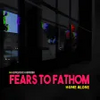A horror game where you play as a 14-year-old trying to survive the night by themselves
A horror game where you play as a 14-year-old trying to survive the night by themselves
Vote: (25 votes)
Program license: Free
Version: 1.1.2
Works under: Windows
Vote:
Program license
(25 votes)
Free
Version
1.1.2
Works under:
Windows
Pros
- High-quality photo-realistic graphics and VHS aesthetic
- Effective narrative-driven gameplay that enhances immersion
- Episodic content allows for standalone experiences within the same universe
- Phone messages and environmental interactions contribute to storytelling
Cons
- Linear gameplay with limited freedom and choice
- Short duration with low replay value
- Episodic releases lack a predictable schedule
Immersive Episodic Horror
Fears to Fathom is an episodic indie horror game developed by Rayll that delivers a spine-chilling narrative-driven experience. As players delve into the unsettling world crafted with photo-realistic graphics and a nostalgically gritty VHS overlay, they are challenged to survive a night fraught with terror and uncertainty.
Atmospheric Storytelling
The game shines in its ability to create a haunting atmosphere. Players find themselves in the role of 14-year-old Miles, who narrates his own terrifying tale from a night spent alone. This leads to a unique gaming format where exploration and progress are heavily tied to the in-game narration that triggers as you interact with your environment and complete specific actions. The incorporation of phone messages from non-playable characters seamlessly weaves into the storytelling, enhancing the sense of realism and immersion within this horror narrative.
Linear Yet Captivating Gameplay
One distinguishing aspect of Fears to Fathom is its approach to storytelling. Since the protagonist's survival is a foregone conclusion—owing to the narrative being a retrospective account—the game sets forth a predetermined path with limited branching. This linearity might restrict free will and exploration to a single narrative trajectory, culminating in either a 'Good' or 'Bad' ending. Despite this, the linear narrative does not detract from the game's allure but rather focuses the player on reliving and unraveling the chain of events that lead to Miles' survival.
Due to its brevity, typically allowing players to complete an episode in under thirty minutes, the game may offer low replay value for those seeking expansively interactive horror. That said, the exquisite stylization of its visuals and the intricate development of tension make for a memorably haunting gaming endeavor.
Episodic Nature and Cohesive Collection
Each installment of Fears to Fathom is self-contained, allowing players to engage with the stories in any order without losing narrative coherence. Although devoid of a strict release schedule for the episodes, this design choice offers a degree of freedom and anticipation as players await new chapters of terror. The game's ability to induce fear and execute jumpscares remains potent and effective, ensuring that each episode contributes to a cohesive collection of horror vignettes.
Verdict
For those intrigued by psychological horror and narrative-rich experiences, Fears to Fathom stands as an impactful choice within the indie game arena. Its method of storytelling, combined with the meticulously crafted atmosphere, makes each episode a potent dosage of dread. While it may not satisfy players yearning for prolonged gameplay or intricate decision-making mechanics, the game undoubtedly succeeds in its aim of delivering a short, sharp shock of horror.
Pros
- High-quality photo-realistic graphics and VHS aesthetic
- Effective narrative-driven gameplay that enhances immersion
- Episodic content allows for standalone experiences within the same universe
- Phone messages and environmental interactions contribute to storytelling
Cons
- Linear gameplay with limited freedom and choice
- Short duration with low replay value
- Episodic releases lack a predictable schedule




